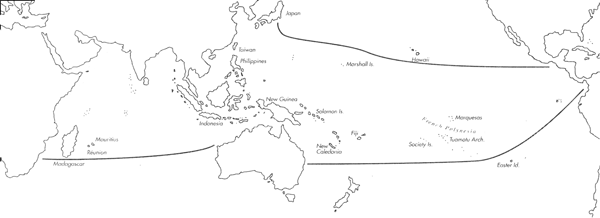Range: Entire Indo-Pacific; also in E. Pacific Region.
Description: Medium-sized to moderately large, moderately solid to moderately heavy. Last whorl conical to broadly conical, sometimes ventricosely or broadly and ventricosely conical; outline convex at subshoulder area, straight below. Shoulder subangulate to angulate. Spire of low to moderate height, outline concave. Larval shell multispiral, maximum diameter 0.7 mm. Teleoconch sutural ramps with 1 increasing to 2-4 spiral grooves, often 2 major grooves and additional spiral striae. Last whorl with variously spaced, weak or incised, often punctate spiral grooves on abapical third.
| Shell Morphometry | ||
|---|---|---|
| L | 30-82 mm | |
| RW | 0.13-0.83 g/mm | |
| (L 30-67 mm) | ||
| RD | 0.58-0.75 | |
| PMD | 0.78-0.92 | |
| RSH | 0.03-0.17 | |
Ground colour white. Last whorl with spiral rows of orange to reddish brown rectangular spots or bars, often alternating with white markings. Dark markings usually cluster or fuse into spiral bands on each side of centre. Base light violet. Larval whorls grey to light orange. Teleoconch sutural ramps with radial markings matching bars on last whorl in size and colour. Aperture white, often suffused with violet or pink.
Periostracum orange or olive brown, thin, variably translucent, and velvety with very fine interlaced axial ridges; in subadults, periostracum very thin and almost colourless but moderately thick and fibrous in large adults.
Foot white to brown; dorsum variably mottled with light brown, with black or brown dots and spots on anterior part forming a triangular pattern, sometimes with a brown premarginal line and a yellow anterior edge; sole often streaked or reticulated with brown. Rostrum uniformly cream or orange ventrally and tan dorsally, with a cream to orange anterior edge. Tentacles white, with scattered black spots, tips sometimes yellow. Siphon white, grading to cream posteriorly, sometimes also mottled with brown, with a broad. sometimes interrupted black ring on anterior part; distal edge white or yellow (Garrett, 1878; Chaberman, pers. comm., 1981; Pearson, unpubl. observ.; Kohn, unpubl. observ.; Fainzilber et al., 1992).
Radular teeth stout, with an adapical barb opposite a blade; serration and basal spur present (Peile, 1939).
Habitat and Habits: Intertidal and subtidal, usually to 40 m; in Philippines, dredged to 240 m; in W. Mexico reported from 15-72 m. On coral reefs and in bays in fine to coarse sand substrate with or without vegetation, muddy sand, and gravel on sheltered flats (Thorson, 1940; Kohn, 1959a, 1960; Hanna, 1963; Cernohorsky, 1964; Keen, 1968; Estival, 1981; Kilburn & Rippey, 1982; Sharabati. 1984; Tirard, pers. comm., 1989; Grosch, pers. comm., 1989; Fainzilber et al., 1992). C. tessulatus feeds on polychaetes. Its venom hardly affects molluscs and small fishes (Endean & Rudkin, 1965; Reichelt & Kohn, 1985). In the Persian Gulf, spawn found attached to rocks, empty bivalve shells and polychaete tubes; capsules of 25-26 x 18-21 mm, arranged in parallel rows, each containing 200-300 eggs. Egg diameter of 250 ┬Ám predicts a minimum pelagic period of about 19 days (Thorson, 1940; Perron & Kohn, 1985).
Discussion: C. tessulatus resembles C. suturatus and C. eburneus. C. suturatus differs in having the first 5-8 postnuclear whorls tuberculate, and in its hardly tessellated colour pattern with 3 background bands. C. eburneus differs in its smaller, dark brown spots and yellowish orange to tan background bands on the last whorl, and its white base. The colour patterns of the animals are also different.

C. tessulatus Range Map
This section contains verbatim reproductions of the accounts of 316 species of Conus from the Indo-Pacific region, from Manual of the Living Conidae, by R÷ckel, Korn and Kohn (1995). They are reproduced with the kind permission of the present publisher, Conchbooks.
All plates and figures referred to in the text are also in R÷ckel, Korn & Kohn, 1995. Manual of the Living Conidae Vol. 1: Indo-Pacific Region.
The range maps have been modified so that each species account has it own map, rather than one map that showed the ranges of several species in the original work. This was necessary because each species account is on a separate page on the website and not confined to the order of accounts in the book.